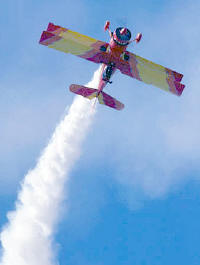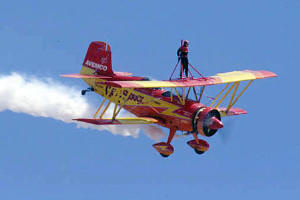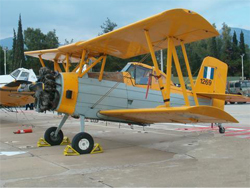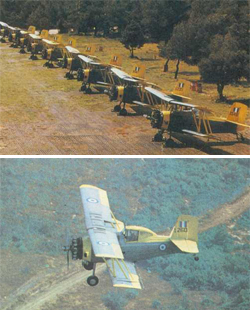THE SHOWCAT
 The "Showcat" is the first Grumman biplane to be used in airshows since the 1930’s when the late Al Williams flew the famed "Gulfhawk". Gene Soucy's new airplane is also the first agricultural aircraft to be used in the airshow environment. Gene has created three new acts with the airplane; a Hollywood style smoke and noise solo routine, a wingwalking act, and a night pyrotechnic show: "Fireflight".
The "Showcat" is the first Grumman biplane to be used in airshows since the 1930’s when the late Al Williams flew the famed "Gulfhawk". Gene Soucy's new airplane is also the first agricultural aircraft to be used in the airshow environment. Gene has created three new acts with the airplane; a Hollywood style smoke and noise solo routine, a wingwalking act, and a night pyrotechnic show: "Fireflight".
The Ag Cat was first designed in 1958 and over 1800 Cats are in use throughout the world. The aircraft carries on the Grumman tradition of a strong over-built airframe and has the best pilot safety record in the ag business.
Soucy’s "Showcat" was modified by Jim Swick at his son’s "Swick Aircraft" facility in McKinney Texas. The six-month project entailed a complete renovation of the former crop sprayer. The hopper was removed and a two seat front cockpit was added for media rides. The entire top of the fuselage was redesigned with a sleeker look including a new rear cockpit, engine cowling, dorsal fin and turtle deck. The wings were clipped to improve roll rate, new gear fairings, wheel pants, and smaller tires were installed. The aircraft was fitted with a Bendix fuel injector and new inverted fuel and oil systems were constructed. The total aerodynamic cleanup improved cross-country cruising speed from 90 MPH to 110 MPH. Swick also installed an airshow smoke system and wing rider stand, plus a wing-tip smoke and pyrotechnic system. The aircraft’s electrical system was removed and completely rewired.
Another interesting feature of the Ag Cat was the removable side panels on the fuselage. No other airshow aircraft provides the ease of accessibility for maintenance, which is so important in this type of flying.
 The combination of the Showcat's light wing-loading and high lift airfoil section provide the perfect slow speed performance for the wingwalking airshow Gene is performing. In the airshow configuration, the Showcat is still operating 1,500 pounds below the maximum weight it was flown at in the cropduster configuration with a full load of chemical.
The combination of the Showcat's light wing-loading and high lift airfoil section provide the perfect slow speed performance for the wingwalking airshow Gene is performing. In the airshow configuration, the Showcat is still operating 1,500 pounds below the maximum weight it was flown at in the cropduster configuration with a full load of chemical.
Gene Soucy states that the modified Ag Cat makes the "perfect airshow airplane". It has all metal construction, ease of maintenance, excellent controllability and good cross-country range. It also has the round engine, the "Pratt & Whitney 985", which provides the earth-shaking noise that has been an airshow tradition since the 1930’s.
In addition to the airshow potential of the airplane as a wingwalking and pyrotechnic platform, it also offers the capability of skywriting and banner towing. If there ever was an airplane created expressly for the airshow industry, it’s the "Showcat".
THE SHOWCAT SPECIFICATIONS
- POWERPLANT
- Pratt & Whitney R-985-14B(450-HP)
- PROPELLER
- Hamilton Standard 2D30-6101-A- 12 Constant Speed
- EMPTY WEIGHT
- 2,900 pounds (with electrical & radio)
- GROSS WEIGHT
- 4,500 pounds
- FUEL CAPACITY
- 102 gallons
- LENGTH
- 24' -9 "
- WINGSPAN
- 37' -6"
- HEIGHT
- 10' -2"
- STRUCTURAL LIMITS
- 6 G's positive, 3 G's negative
- TOP SPEED
- 190 mph
- CRUISE SPEED
- 100 mph
- STALL SPEED
- 45 mph
- RATE OF CLIMB
- 1,200 ft/minute at sea level
- INVERTED FLIGHT TIME
- Unlimited
Ag-Cats in the Military
 Gene Soucy’s “Show-Cat” originally began as a Grumman Ag-Cat agricultural airplane. It was used as a sprayer in the rice fields of southwestern Louisiana. Interestingly enough, however, it also has a history in U.S. Military Service and in the Greek Air Force.
Gene Soucy’s “Show-Cat” originally began as a Grumman Ag-Cat agricultural airplane. It was used as a sprayer in the rice fields of southwestern Louisiana. Interestingly enough, however, it also has a history in U.S. Military Service and in the Greek Air Force.
During the early Mercury Program, the Grumman Ag-Cat was used by NASA to research the techniques of capturing a returning spacecraft while under its parachute. The tests with the Ag-Cat were not successful, and the technique was instead performed by C-119 aircraft. The Ag-Cat was also used to test the techniques of picking up downed aviators with a fixed wing aircraft by snagging a balloon and pulling the person aboard with a cable. This also proved unsuccessful and was later performed with a B-17. Unfortunately, there are no records available for the Ag-Cat test projects as these missions for NASA and the USAF were Top Secret Programs.
The G-164 Ag-Cat was also utilized in the Hellenic Air Force primarily for crop-dusting/defoliation beginning in 1957.
The Ag-Cat is one of the most successful purpose designed agricultural aircraft yet to be built and has been in almost continuous production since 1959. The G-164 Ag-Cat biplane was developed by Grumman in the mid 1950s, and the prototype made its maiden flight on May 27, 1957. Production began in 1959 which delivered some 400 initial G-164 Ag-Cats. After Grumman produced two more prototypes, he subcontracted Schweizer to build all Ag-Cats for him. Grumman American was formed in 1973, and responsibility for the Ag-Cat was transferred to the new company. In 1978, the company was renamed to Gulfstream American, and in January 1981, Schweizer bought the design and marketing rights and became solely responsible for the Ag-Cat program. In 1995, Schweizer sold the Ag-Cat's manufacturing rights to the Ag-Cat Corp of Malden, MO, who have built a small number of aircraft.

